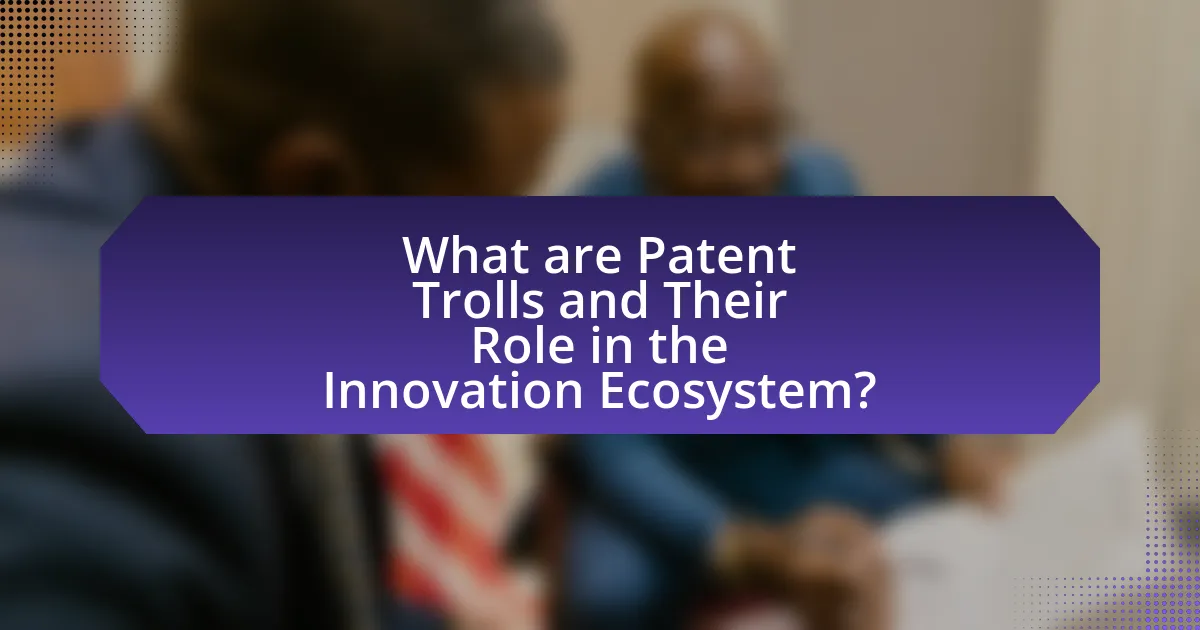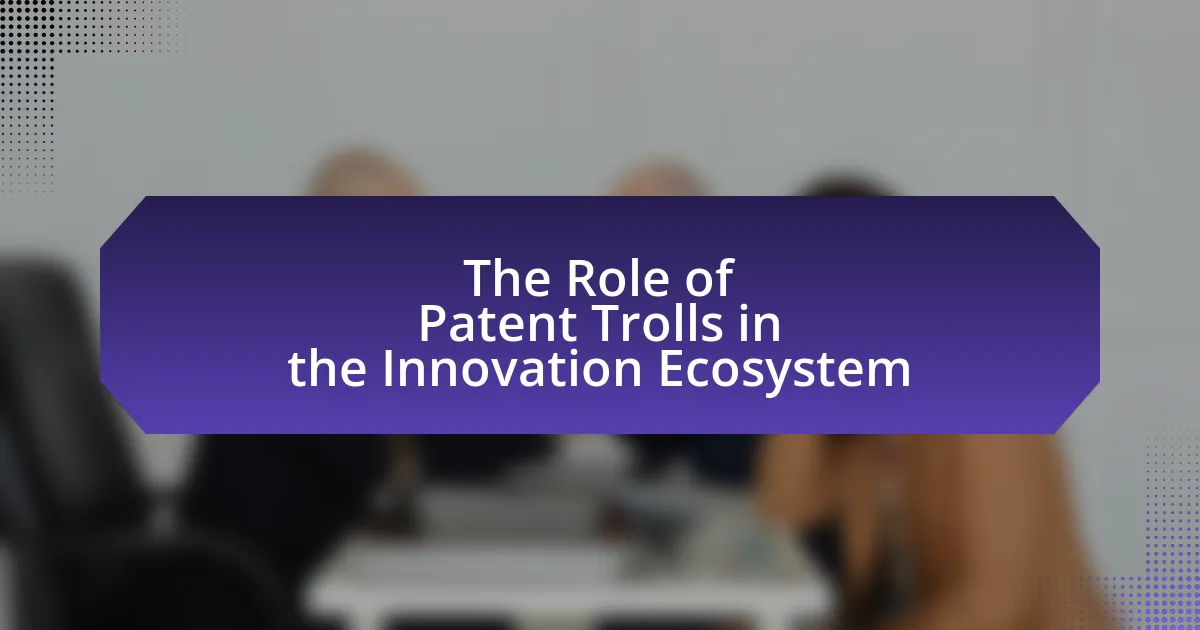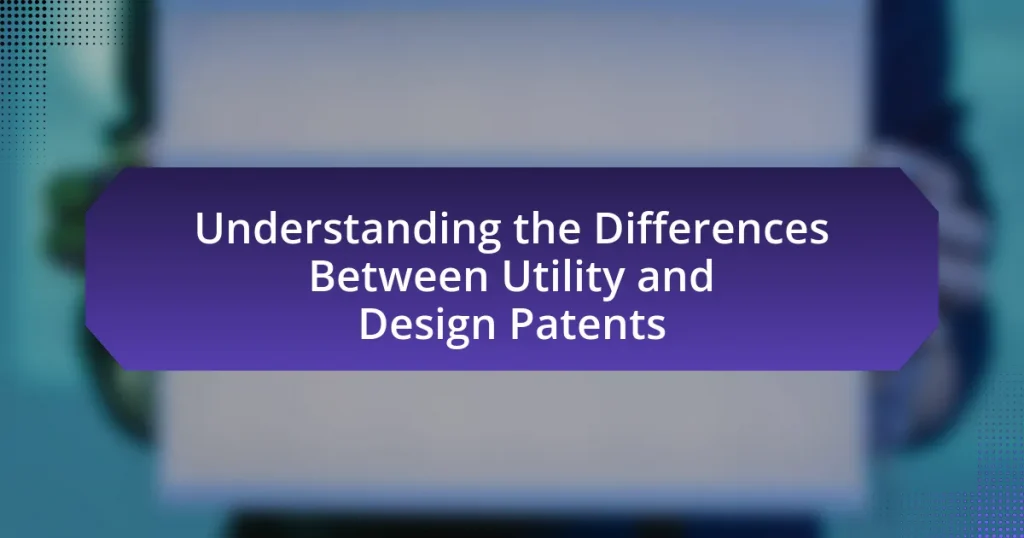Patent trolls, or non-practicing entities, are organizations that acquire patents primarily to enforce them against other companies rather than to develop products or technologies. This article examines the significant impact of patent trolls on the innovation ecosystem, highlighting their role in stifling innovation through aggressive litigation and the financial burdens they impose on startups and established businesses. Key topics include the operational strategies of patent trolls, their effects on market competition and investment in innovation, the legal frameworks that enable their activities, and proposed reforms to mitigate their influence. Additionally, the article discusses strategies companies can adopt to protect themselves from patent troll litigation and the future trends regarding patent trolls in the innovation landscape.

What are Patent Trolls and Their Role in the Innovation Ecosystem?
Patent trolls are entities that acquire patents, often without the intention of developing the associated technology, and primarily use them to extract settlements or licensing fees from other companies. These entities can hinder innovation by creating a climate of fear among startups and established companies, who may avoid developing new products due to the risk of litigation. According to a study by the Boston University School of Law, patent trolls accounted for 67% of all patent litigation in the United States in 2016, illustrating their significant impact on the legal landscape and innovation ecosystem.
How do Patent Trolls operate within the innovation landscape?
Patent trolls operate by acquiring patents, often without the intention of developing products or services, and then using these patents to threaten or file lawsuits against companies that they believe infringe on their intellectual property. This practice creates a chilling effect on innovation, as companies may choose to settle out of court rather than face costly legal battles. According to a study by the Boston University School of Law, patent litigation initiated by non-practicing entities, commonly referred to as patent trolls, has increased significantly, with over 60% of patent lawsuits in the U.S. attributed to these entities. This trend highlights how patent trolls exploit the legal system to extract settlements, thereby diverting resources away from research and development, which is essential for genuine innovation.
What strategies do Patent Trolls use to enforce patents?
Patent trolls enforce patents primarily through aggressive litigation strategies. They often target companies with deep pockets, filing lawsuits for alleged patent infringement to extract settlements. These entities frequently acquire patents not to innovate but to leverage them against operating companies, creating a financial burden that encourages settlements rather than prolonged legal battles. According to a study by the Boston University School of Law, patent trolls accounted for over 60% of patent litigation in the U.S. in recent years, highlighting their prevalence and impact on the innovation ecosystem. Additionally, they may employ tactics such as threatening to sue or sending demand letters to intimidate companies into compliance, further demonstrating their reliance on legal pressure to enforce patent rights.
How do Patent Trolls identify potential targets for litigation?
Patent trolls identify potential targets for litigation by analyzing existing patents and assessing the market activities of companies that may infringe on those patents. They often focus on industries with high innovation rates, such as technology and pharmaceuticals, where the risk of unintentional infringement is greater. Additionally, patent trolls utilize databases and patent analytics tools to identify companies that have been previously involved in patent disputes or those that have significant financial resources, making them more likely to settle. This strategic targeting is supported by the fact that, according to a study by the Boston University School of Law, patent litigation settlements often favor the patent holder, incentivizing trolls to pursue companies with substantial assets.
Why are Patent Trolls considered a controversial element in the innovation ecosystem?
Patent trolls are considered a controversial element in the innovation ecosystem because they exploit patent laws to generate revenue through litigation rather than by developing new products or technologies. This practice creates a chilling effect on innovation, as companies may divert resources from research and development to defend against lawsuits. According to a study by the Boston University School of Law, patent trolls accounted for over 60% of patent litigation in the United States, highlighting their significant impact on the legal landscape and the burdens they impose on legitimate innovators.
What impact do Patent Trolls have on startups and small businesses?
Patent trolls significantly hinder startups and small businesses by imposing legal and financial burdens through aggressive patent litigation. These entities, which acquire patents solely to enforce them against alleged infringers, create an environment of fear and uncertainty. According to a study by the Boston University School of Law, patent litigation can cost defendants upwards of $1 million, which is often unsustainable for smaller companies. This financial strain can divert resources away from innovation and growth, leading to reduced competitiveness in the market. Furthermore, the threat of litigation can deter startups from pursuing new ideas, stifling overall innovation within the ecosystem.
How do Patent Trolls affect the overall innovation process?
Patent trolls negatively impact the overall innovation process by creating a climate of fear and uncertainty among innovators and startups. These entities, which acquire patents solely to enforce them against companies rather than to produce products, often engage in aggressive litigation tactics. This behavior diverts resources away from research and development, as companies must allocate funds to legal defenses instead of innovation. A study by the Boston University School of Law found that patent litigation costs can exceed $1 million per case, which disproportionately affects smaller firms and stifles their ability to innovate. Consequently, the presence of patent trolls can lead to reduced technological advancement and a less competitive market.

What are the Economic Implications of Patent Trolls?
Patent trolls negatively impact the economy by stifling innovation and imposing significant costs on businesses. These entities, which acquire patents solely to enforce them against alleged infringers, create a climate of uncertainty that discourages investment in research and development. According to a study by the Boston University School of Law, patent litigation initiated by trolls costs U.S. companies approximately $29 billion annually, diverting resources away from productive activities. Furthermore, the presence of patent trolls can lead to increased prices for consumers, as companies often pass on the costs of litigation and settlements. This economic burden ultimately hampers technological advancement and competitiveness in the market.
How do Patent Trolls influence market competition?
Patent trolls influence market competition by creating barriers for innovation and increasing costs for companies through aggressive litigation. These entities, which typically hold patents without intending to produce products or services, often target established firms and startups alike, leading to costly legal battles. For instance, a study by the Boston University School of Law found that patent litigation can cost companies an average of $1.5 million per case, diverting resources away from research and development. This practice discourages new entrants into the market and stifles competition, as smaller companies may lack the financial means to defend against such lawsuits. Consequently, the presence of patent trolls can lead to reduced innovation and a less competitive market landscape.
What costs do Patent Trolls impose on companies?
Patent trolls impose significant financial costs on companies through litigation expenses, settlement payments, and diversion of resources. Companies often face legal fees that can range from hundreds of thousands to millions of dollars when defending against patent infringement claims, even if the claims are baseless. For instance, a study by the Boston University School of Law found that patent litigation can cost defendants an average of $1.5 million in legal fees. Additionally, companies may opt to settle disputes to avoid lengthy litigation, leading to further financial losses. The diversion of management and employee time to address these legal challenges can also hinder innovation and operational efficiency, ultimately impacting a company’s competitive position in the market.
How do Patent Trolls affect investment in innovation?
Patent trolls negatively impact investment in innovation by creating an environment of uncertainty and fear among investors and startups. These entities, which acquire patents solely to enforce them against companies, often engage in litigation rather than developing products. This behavior leads to increased legal costs and potential damages for companies, discouraging them from investing in new technologies or entering certain markets. A study by the Boston University School of Law found that patent litigation can cost companies an average of $1.5 million per case, which diverts funds away from research and development. Consequently, the presence of patent trolls stifles innovation by making it riskier and more expensive for businesses to pursue new ideas.
What are the legal frameworks surrounding Patent Trolls?
The legal frameworks surrounding patent trolls primarily involve patent law, specifically the enforcement of patent rights under the United States Patent Act and related statutes. Patent trolls, or non-practicing entities (NPEs), exploit these laws by acquiring patents and enforcing them against alleged infringers, often through litigation, without intending to manufacture or market the patented inventions.
The America Invents Act (AIA) of 2011 introduced mechanisms such as inter partes review (IPR) to challenge patent validity, which can mitigate the impact of patent trolls by allowing accused infringers to contest patents more efficiently. Additionally, the Federal Trade Commission (FTC) has issued reports highlighting the negative effects of patent trolling on innovation and competition, prompting discussions on potential reforms to patent laws to deter abusive litigation practices.
Court rulings, such as the Supreme Court’s decision in Octane Fitness v. ICON Health & Fitness (2014), have also influenced the legal landscape by making it easier for courts to award attorney fees to prevailing defendants in patent cases, thereby discouraging frivolous lawsuits by patent trolls.
How do current patent laws enable or hinder Patent Trolls?
Current patent laws enable Patent Trolls by allowing them to exploit vague and broad patents to initiate litigation against companies, often without producing any products themselves. This exploitation is facilitated by the legal framework that permits patent holders to sue for damages, which can lead to significant settlements or licensing fees, even if the patents are weak or questionable. For instance, a study by the Boston University School of Law found that non-practicing entities, commonly referred to as Patent Trolls, accounted for over 60% of patent litigation in the U.S. from 2010 to 2016, highlighting how the existing legal environment supports their business model. Conversely, some recent reforms, such as the America Invents Act, have introduced mechanisms like inter partes review, which can hinder Patent Trolls by allowing challenges to patent validity before litigation, thus providing a counterbalance to their activities.
What reforms are being proposed to address the issues caused by Patent Trolls?
Reforms proposed to address issues caused by patent trolls include legislative changes aimed at increasing transparency in patent ownership, implementing fee-shifting provisions to deter frivolous lawsuits, and enhancing the standards for patent validity. For instance, the Innovation Act, introduced in Congress, seeks to require patent holders to disclose their ownership and to provide detailed information about the patent’s claims, which can help identify and reduce abusive litigation practices. Additionally, studies have shown that jurisdictions with fee-shifting rules, where the losing party pays the winner’s legal fees, experience a decrease in patent troll activity, indicating that such reforms can effectively mitigate the negative impact of patent trolls on innovation.

What Strategies Can Companies Use to Combat Patent Trolls?
Companies can combat patent trolls by employing strategies such as proactive patent management, legal defenses, and collaborative approaches. Proactive patent management involves conducting thorough patent audits to identify and strengthen their own patent portfolios, which can deter trolls from targeting them. Legal defenses include utilizing the “customer suit exception,” where companies can challenge patent trolls by arguing that the end-users of their products should be the ones sued, not the manufacturers. Collaborative approaches involve forming alliances with other companies to share information and resources, which can enhance their collective bargaining power against patent trolls. For instance, the Coalition for Patent Fairness, which includes major tech companies, aims to reform patent laws to reduce the impact of trolls. These strategies are supported by data showing that companies with robust patent portfolios and collaborative networks are less likely to be successfully targeted by patent trolls.
How can businesses protect themselves from Patent Troll litigation?
Businesses can protect themselves from Patent Troll litigation by implementing robust patent management strategies, including conducting thorough patent searches and obtaining legal opinions on their products. These proactive measures help identify potential infringement risks and ensure that businesses are not unknowingly violating existing patents. Additionally, companies can invest in defensive patent portfolios, which can deter patent trolls by providing counterclaims or negotiating leverage. According to a study by the Boston University School of Law, companies with strong patent portfolios are less likely to be targeted by patent trolls, as they can effectively defend against claims. Furthermore, businesses can engage in collective defense strategies, such as joining industry coalitions that share resources and information to combat patent troll activities.
What role does patent insurance play in mitigating risks?
Patent insurance plays a crucial role in mitigating risks associated with patent litigation and infringement claims. By providing financial protection against the costs of legal disputes, patent insurance enables companies to defend their intellectual property rights without the fear of crippling legal expenses. For instance, a study by the Intellectual Property Owners Association indicates that patent litigation can cost companies upwards of $1 million, making insurance a strategic tool for risk management. This financial safety net allows businesses to focus on innovation and growth rather than being deterred by the potential for costly legal battles.
How can companies leverage defensive patent strategies?
Companies can leverage defensive patent strategies by acquiring patents that cover their own innovations and potential competitors’ technologies to deter infringement lawsuits. This approach allows firms to create a portfolio of patents that can be used as a bargaining tool in negotiations, thereby reducing the risk of litigation from patent trolls. For instance, a study by the Boston Consulting Group found that companies with robust patent portfolios are less likely to be targeted by patent trolls, as the presence of patents can discourage aggressive litigation tactics. Additionally, companies can engage in cross-licensing agreements, which enable them to share patents with other firms, further enhancing their defensive posture against potential infringement claims.
What best practices should companies adopt to navigate the challenges posed by Patent Trolls?
Companies should adopt proactive legal strategies, including thorough patent portfolio management and defensive patenting, to navigate the challenges posed by patent trolls. By conducting regular audits of their intellectual property, companies can identify vulnerabilities and strengthen their positions against potential infringement claims. Engaging in defensive patenting, where companies acquire patents not for commercialization but to deter litigation, can also serve as a deterrent against patent trolls. Furthermore, companies should consider joining or forming alliances with industry groups that focus on patent reform, as collective action can enhance their bargaining power and reduce the risk of litigation. Statistics show that companies with robust patent strategies are less likely to be targeted by patent trolls, as evidenced by a 2019 study from the Boston University School of Law, which found that firms with comprehensive patent portfolios faced significantly fewer infringement lawsuits.
How can collaboration among companies help reduce the threat of Patent Trolls?
Collaboration among companies can significantly reduce the threat of patent trolls by creating a united front against infringement claims. When companies pool resources and share information, they can develop collective strategies to challenge patent troll activities, such as forming alliances to defend against lawsuits or investing in shared legal defenses. For instance, the formation of the Coalition for Patent Fairness, which includes multiple tech companies, has been instrumental in advocating for patent reform and reducing the power of patent trolls. This collaborative approach not only dilutes the financial impact on individual companies but also enhances their ability to negotiate and settle disputes effectively, thereby minimizing the overall threat posed by patent trolls.
What resources are available for companies facing Patent Trolls?
Companies facing patent trolls can utilize several resources, including legal counsel specializing in intellectual property, industry associations that provide support and advocacy, and public awareness campaigns to educate stakeholders about patent trolling. Legal counsel can help navigate the complexities of patent law and develop strategies to counteract infringement claims. Industry associations, such as the Computer & Communications Industry Association, offer resources, networking opportunities, and lobbying efforts to influence policy against patent trolls. Public awareness campaigns, like those led by the Electronic Frontier Foundation, aim to inform the public and lawmakers about the negative impacts of patent trolling on innovation and competition. These resources collectively empower companies to defend against patent troll activities effectively.
What are the Future Trends Regarding Patent Trolls in the Innovation Ecosystem?
Future trends regarding patent trolls in the innovation ecosystem indicate an increase in legislative and judicial scrutiny aimed at curbing their activities. Recent data shows that patent litigation cases involving non-practicing entities (NPEs), commonly referred to as patent trolls, have declined by approximately 40% since 2015, suggesting a shift towards more stringent enforcement of patent laws. Additionally, companies are increasingly adopting defensive strategies, such as patent pools and collaborative licensing agreements, to mitigate the risks posed by patent trolls. This trend is supported by the rise of initiatives like the Innovation Act, which aims to reduce frivolous lawsuits and enhance transparency in patent ownership.
How might changes in technology impact the activities of Patent Trolls?
Changes in technology can significantly enhance the activities of patent trolls by providing them with advanced tools for identifying potential infringement and streamlining litigation processes. For instance, the rise of artificial intelligence and big data analytics allows patent trolls to efficiently analyze vast amounts of patent data and identify companies that may be infringing on their patents. According to a study by the Boston University School of Law, patent litigation has increased by over 200% since 2000, largely driven by the capabilities of technology that enable patent trolls to target a wider range of companies with greater precision. Additionally, improvements in communication technology facilitate quicker and more widespread dissemination of patent claims, increasing the likelihood of settlements before cases reach court. Thus, technological advancements not only empower patent trolls to operate more effectively but also contribute to the growing prevalence of patent litigation in the innovation ecosystem.
What role will legislation play in shaping the future of Patent Trolls?
Legislation will play a crucial role in shaping the future of patent trolls by establishing stricter regulations and guidelines that limit their ability to exploit the patent system. Recent legislative efforts, such as the Innovation Act of 2013 and the STRONG Patents Act, aim to reduce frivolous lawsuits and increase transparency in patent ownership, which directly targets the tactics used by patent trolls. These legislative measures are designed to protect legitimate innovators and businesses from abusive litigation practices, thereby fostering a healthier innovation ecosystem.



